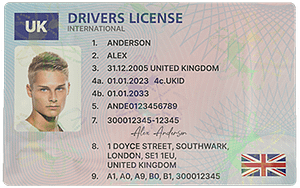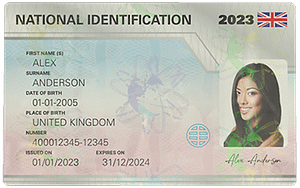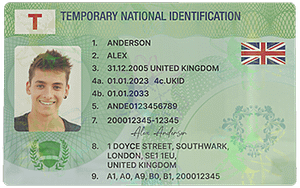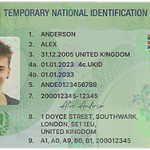Fake ID card offenses are serious violations of the law that undermine the integrity of identification – related systems and can lead to various negative consequences such as identity theft, fraud, and illegal access to services. Understanding the legal process for prosecuting such offenses is crucial for law – enforcement agencies, legal professionals, and the general public. This article will delve into the various steps involved in the prosecution of fake ID card offenses.
Investigation
The legal process for prosecuting fake ID card offenses typically begins with an investigation. Law – enforcement agencies play a key role in this stage. They may receive tips from the public, intelligence sources, or during the course of other investigations that lead them to suspect fake ID card activities. For example, a retailer may report a customer presenting a suspicious – looking ID card, or a bank may notice irregularities in an account opening process due to a potentially fake ID.
During the investigation, law – enforcement officers will gather evidence. This can include physical evidence such as the fake ID card itself, any equipment used in the production of fake IDs (such as printers, scanners, and blank card materials), and records related to the transactions or activities involving the fake ID. They may also conduct interviews with witnesses, victims (if applicable), and suspects. Surveillance techniques may be employed in some cases to monitor the activities of individuals suspected of being involved in the production or distribution of fake ID cards.

Arrest and Booking
Once there is sufficient evidence to support the suspicion of a fake ID card offense, law – enforcement officers may proceed with an arrest. The arrest is carried out in accordance with the legal procedures and requirements of the jurisdiction. The suspect is informed of their rights, including the right to remain silent and the right to an attorney.
After the arrest, the suspect is taken to a police station for booking. During the booking process, personal information about the suspect is recorded, such as name, address, date of birth, and physical description. A photograph and fingerprints may also be taken. The suspect is then informed of the charges against them, which in the case of fake ID card offenses may include forgery, fraud, or identity theft, depending on the nature and circumstances of the offense.
Initial Appearance
The suspect is required to make an initial appearance in court soon after the arrest. This is usually within a short period, often within 24 – 48 hours. At the initial appearance, the judge will inform the suspect of the charges against them, their rights, and may set bail if applicable.

The judge will consider various factors when setting bail, such as the nature of the offense, the suspect’s criminal history, and the likelihood of the suspect appearing for future court dates. If the suspect cannot afford to post bail, they may remain in custody until the next stage of the legal process.
Preliminary Hearing
In some cases, a preliminary hearing may be held. The purpose of the preliminary hearing is to determine if there is enough evidence to hold the suspect for trial. The prosecution will present its evidence, which may include witness testimony, physical evidence, and expert opinions. The defense has the opportunity to cross – examine the prosecution’s witnesses and present its own evidence if it chooses.
If the judge determines that there is sufficient evidence to support the charges, the case will be bound over for trial. If not, the charges may be dismissed. The preliminary hearing is an important safeguard in the legal process to ensure that only cases with a reasonable basis proceed to trial.

Grand Jury Indictment (in some jurisdictions)
In some jurisdictions, instead of a preliminary hearing, the prosecution may present the case to a grand jury. A grand jury is a group of citizens who are responsible for determining whether there is enough evidence to indict the suspect. The grand jury proceedings are usually secret, and the prosecution presents its evidence to the grand jury in private.
The grand jury will then decide whether to issue an indictment. If an indictment is issued, the suspect is formally charged with the offense and the case proceeds to trial. If the grand jury does not find sufficient evidence, no indictment will be issued, and the case may be dismissed.
Trial
The trial is the most crucial stage in the prosecution of fake ID card offenses. Both the prosecution and the defense present their cases in front of a judge or a jury (depending on the jurisdiction and the nature of the case). The prosecution has the burden of proving the suspect’s guilt beyond a reasonable doubt.
The prosecution will call witnesses to testify, present physical evidence, and use expert testimony if necessary to establish the elements of the fake ID card offense. The defense, on the other hand, will challenge the prosecution’s evidence, cross – examine the prosecution’s witnesses, and may present its own witnesses and evidence to raise doubts about the prosecution’s case. At the end of the trial, the judge or the jury will make a decision on the suspect’s guilt or innocence.
Sentencing
If the suspect is found guilty of a fake ID card offense, the next stage is sentencing. The judge will consider various factors when determining the sentence, such as the severity of the offense, the suspect’s criminal history, and any mitigating or aggravating circumstances. Penalties for fake ID card offenses can range from fines and probation to imprisonment, depending on the jurisdiction and the nature of the offense.
For example, if the fake ID card was used for minor fraud or to gain access to a restricted area, the sentence may be relatively lenient, such as a fine and a short – term probation. However, if the fake ID card was part of a large – scale identity theft operation or was used to commit serious crimes, the sentence may be more severe, including a significant period of imprisonment.
Appeals
The convicted suspect has the right to appeal the conviction or the sentence. The appeal process is based on legal grounds, such as errors in the trial proceedings, new evidence that was not available during the trial, or misapplication of the law. The appeal is usually heard by a higher court.
The higher court will review the case record and the legal arguments presented by the appellant (the convicted suspect) and the prosecution. If the higher court finds that there were legal errors that affected the outcome of the trial, it may reverse the conviction, order a new trial, or modify the sentence.
Common Problems and Solutions
- Problem: Difficulty in Gathering Sufficient Evidence
Solution: Law – enforcement agencies should invest in training their officers on advanced investigation techniques, such as digital forensics to analyze electronic evidence related to fake ID card production and use. They should also encourage the public to come forward with information by providing incentives and ensuring the protection of whistle – blowers.
- Problem: Identifying the Source of Fake ID Cards
Solution: Establishing international cooperation between law – enforcement agencies can be crucial, as fake ID card production may be trans – national. Sharing intelligence and resources with foreign counterparts can help trace the origin of fake ID cards and target the key players in the production and distribution networks.
- Problem: Challenges in Cross – Examining Expert Witnesses
Solution: Defense attorneys should be well – versed in the relevant scientific and technical knowledge related to fake ID card detection. They can also hire their own experts to counter the prosecution’s expert witnesses and raise doubts about the prosecution’s evidence.
- Problem: Suspects Fleeing Before the Trial
Solution: Law – enforcement agencies should use modern surveillance and tracking technologies, such as GPS monitoring and facial recognition systems, to ensure that suspects do not flee. Additionally, setting appropriate bail conditions and imposing strict reporting requirements can act as deterrents.
- Problem: Inconsistent Sentencing across Jurisdictions
Solution: There should be more standardized sentencing guidelines for fake ID card offenses at a national or regional level. This can ensure fairness and consistency in the criminal justice system and prevent disparities in the punishment of similar offenses.


